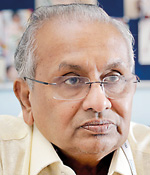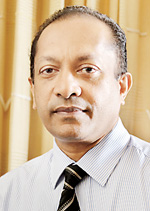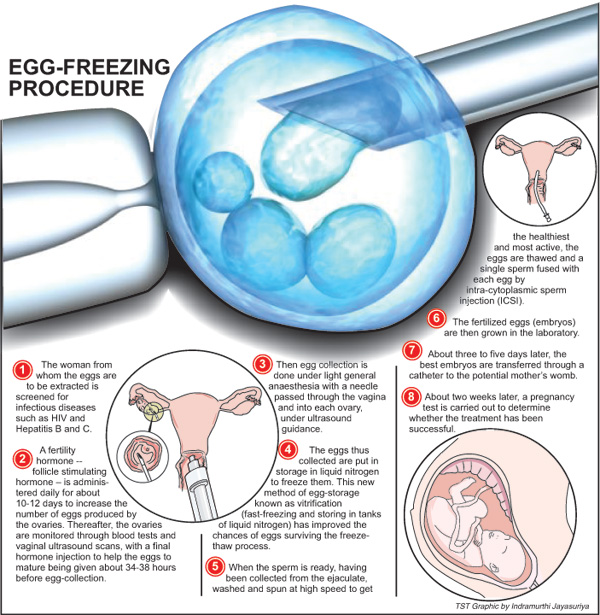Sunday Times 2
A baby coming in from the cold
There is an air of expectancy and excitement in a home in Amparai. Even though housewife Kala* and husband Raj* go about their routines, the yearning is for October to come around. For on the 25th of the tenth month of this year, they will experience the joys of parenthood.
While the couple await their baby, for Sri Lanka it will be a birth of a different kind – the launch of a technique, relatively new even across the world, bringing hope to couples in despair, grappling with fertility issues.
Egg freezing is now a reality in the country, taking Assisted Reproductive Technology (ART) to a different level and making Kala and Raj the trailblazers.
Seated in a consultation room on the 10th Floor of the Prarthana Fertility Centre of the Golden Key Eye Hospital at Rajagiriya in Colombo, it is Fertility Specialist Dr. M. Sathanandan, pioneer of egg freezing in the country in January this year, who dwells on the procedure.
Not only egg freezing but also the whole treatment of both Kala and Raj is being carried out at the Prarthana Fertility Centre under the expertise of Dr. Sathanandan, a Consultant Obstetrician and Gynaecologist, whose team consists of laboratory scientists from this centre and Ninewells Hospital.
Desperate to have a baby, 41-year-old Kala and Raj had first sought the help of Dr. M. Thirukumar, Consultant Obstetrician and Gynaecologist and Senior Lecturer at the Eastern University’s Medical Faculty, in Batticaloa.
The situation was bleak for the couple who had been married for about five years. For, Kala had a poor egg (ovum) reserve and it was then that they were referred to Dr. Sathanandan.

Dr. M. Sathanandan
Explaining that as a woman’s age advances, 35-38, 38-40, 40-42, 42+, the chances of conceiving a baby with her own eggs become difficult, as the quality of eggs declines, Dr. Sathanandan points out that it is then that donor eggs come in handy. “Usually, when a girl is born, she already has 500,000 eggs per ovary, which means there is a bank of one million eggs in the two ovaries. From the time a girl reaches menarche, with menstruation, 100-150 eggs are shed every month. Therefore, the pool of eggs decreases gradually,” he says.
Once Kala and Raj were assessed, the couple was advised on the possibility of using donor eggs. These eggs would then be fertilized by Raj’s sperm through intra-cytoplasmic sperm injection (ICSI) and the resultant embryo grown in a petri dish kept in an incubator in the centre’s laboratory. Thereafter it would be implanted in Kala’s womb (uterus) as is done in in-vitro fertilization procedures. She would then carry the foetus to term in her womb.
When the couple readily agreed, the donor egg collection was set for January 21, this year, says Dr. Sathanandan, adding however that on that day, a different problem cropped up. Although when screened earlier, Raj was found to have usable sperm, on January 21, no sperm was found in his ejaculate. It was a temporary phenomenon and they had two options — either using donor sperm or freezing the donor eggs until they could get usable sperm from the husband. It was the second option that the couple was in favour of.
“Freezing eggs on January 21 was the first time for me,” smiles Dr. Sathanandan, explaining that the first reported human birth using eggs that had been frozen and then thawed was in 1986. The procedure had been carried out at the Queen Elizabeth Hospital in Adelaide, Australia, and was so difficult that it could not be replicated for several years thereafter. The difficulty lay in thawing the frozen eggs without damaging them.
When freezing eggs, the largest cells in the human body which have a lot of water in them, there would be ice-crystal formation, according to Dr. Sathanandan. This leads to their structure being damaged. About seven years ago, however, came vitrification, which revolutionised the whole process. Here the eggs are dehydrated and the water within them replaced with anti-freeze to prevent ice crystals being formed.
Performed only in fertility centres of excellence in the three main clusters of the United States of America, Western Europe and Australia, there are still fewer than 2,000 babies who have been born using frozen eggs, it is learnt. On average, the success rate is 10%, which means that of 10 frozen eggs, there would only be one live baby.
Having frozen the donor eggs on January 21 using a sophisticated machine at the Prarthana Fertility Centre, the team was able to extract good sperm on the eighth day (January 29) from Raj’s ejaculate.
“We immediately thawed the eggs and through ICSI injected the sperms into five eggs. Waiting and watching in excitement, we found that three got fertilized 24 hours later forming embryos. We grew these three embryos up to the blastocyst stage (when on the fifth day after ICSI, the embryo divides into 32 cells) and transferred the two that survived into Kala’s womb on February 3,” says Dr. Sathanandan.
One embryo beat the other in the race to get implanted (fixed) onto Kala’s womb wall, becoming a single foetus, he explains, adding that although Kala had a poor egg reserve, her womb is normal and she can carry her baby.
At 13½ weeks, Foetal Medicine Specialist Dr. Tiran Dias performed a 4-Dimensional Scan to check the anatomy of the foetus, while the next scan will be at 22 weeks. “Mother and baby are doing fine,” says Dr. Sathanandan, adding that the baby is due to be born on October 25.
(* Names have been changed to protect identities)
| Eggs can be stored for ten years in egg bank With the Prarthana Fertility Centre setting up a frozen egg bank, Executive Director of Golden Key Reproductive Health Ltd., Nishantha Dantanarayana says that they already have about 15 eggs in storage. As donors come forward as the message spreads through word of mouth, he says that Sri Lanka being a predominantly Buddhist country, women are ready to donate eggs to help their needy sisters.  Nishantha Dantanarayana Even though Sri Lanka launched Assisted Reproductive Technology (ART) as far back as 1999 in the private sector, no one has ventured into freezing eggs up to now, going by published records, according to Dr. Sathanandan. So far, globally about five million babies have been born using ART since July 25, 1978 when the first ‘test-tube baby’ Louise Brown was born in England. Immediate threat to fertility because of chemotherapy or pelvic radiation therapy. Genetic mutations requiring ovary-removal surgery or oophorectomy. (This includes BRCA gene-mutation carriers who have an increased risk of breast cancer). | |


